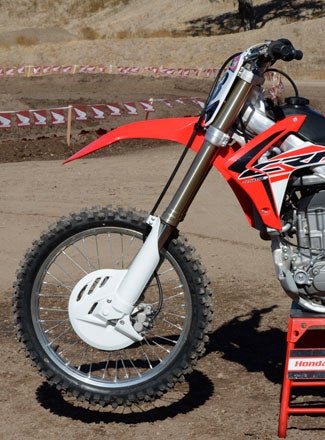
To understand the basics of the PSF, KYB officials walked us through the fork at the intro. The PSF is designed to compartmentalize the compression and rebound adjustments similar to the SFF, but the technical highlight of the fork is that both sides feature high- and low-speed adjusters, giving the PSF an amazingly fine degree of tuneability. The compression damping circuit is located in the left leg, and the rebound damping circuit is in the right leg, with the valve specs being the same on both sides. The fork is also self-lubricating. When the fork compresses, the displaced oil travels through a bleed port at the bottom of the shock and through the space between the inner and outer fork tubes, reducing friction. KYB has also taken contamination defense to the next level by adding a dust scraper between the dust seal and the oil seal on each fork leg. It is basically a second line of defense against any debris that makes it past the dust seal.
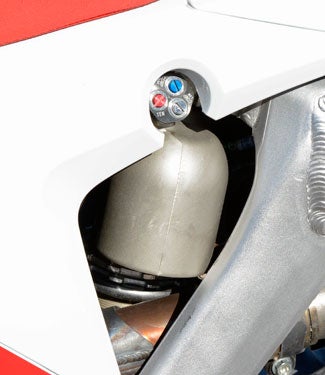
The CRF450R’s KYB suspension is as forgiving a package as any in its class. Whether Abbatoye was hammering a G-force landing off of one of the track’s big jumps or pounding through ruts, the fork and the shock were plush and smooth at both ends without bottoming. With 12.2 inches of front wheel travel available, the fork’s excellent control should inspire confidence in any Novice rider. Out back, the shock works with the Honda’s rising-rate linkage rear suspension to keep the rear end in line at all times, offering excellent traction, especially during hard acceleration out of rutted corners.
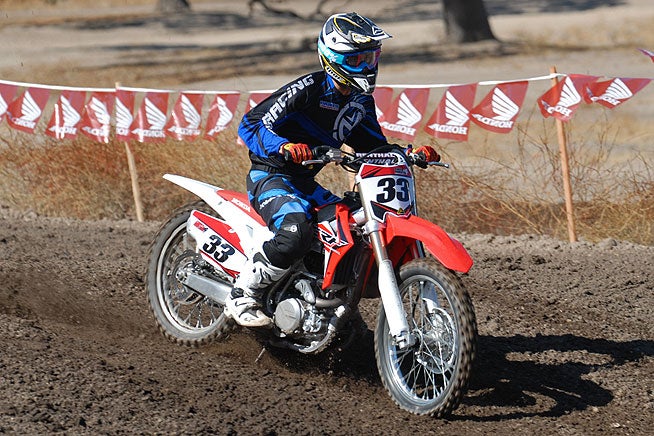
The revised suspension also influences the CRF450R’s handling, and it’s for the better, Abbatoye said. With a 58.7-inch wheelbase, 27-degree steering head angle and 4.6 inches of trail, the CRF450R’s numbers don’t significantly set it apart from other chassis in the class, so suspension balance is all the more critical. Honda got it right with the KYB suspension this year.
“In the past, Hondas have always felt ‘stinkbug’ to me, where the front end is low and the rear end is high, which makes the chassis unstable,” Abbatoye said. “Now it feels more balanced front to rear, and it is way more stable. I know that Honda was aware of the stinkbug issue, and they worked really hard to change it. They did, and it’s more planted, more predictable and not as twitchy now. It’s a big improvement.
On the other hand, it isn’t perfect.
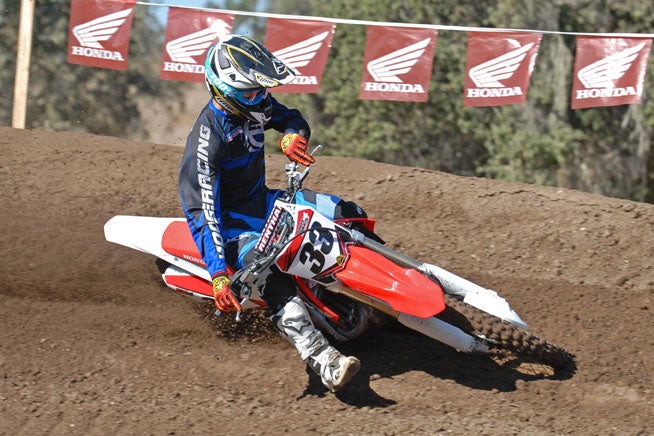
“No, I do have one complaint,” Abbatoye added. “I noticed that while the front end tracked well in ruts, it wanted to wash out on some of the ridges that were forming in some of the turns at Zaca. Every bike will do it to some degree, but the Honda is more sensitive to it. So, I had to check up for stuff like that or be more careful with my line selection. I chose a couple different lines just for that reason. But overall, the chassis is really good, and the faster you go the better it gets.”
Brakes and tires are two more areas where the CRF450R has received attention in 2015. Up front, the Honda gets a new, 20mm larger rotor, measuring 260mm in diameter, while the 245mm rear rotor now features more of a wave pattern design than the previous version. Both are clamped by Nissin calipers, a two-piston unit up front and a single-piston unit out back. Are they improvements of the same magnitude as the engine and suspension? Not really, but that’s no big knock, according to Abbatoye.
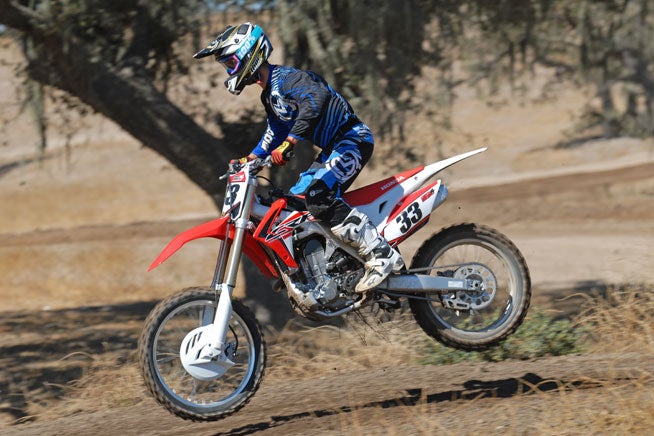
Dunlop’s MX32 and MX52 tires may just be the single hottest off-road product to be introduced in 2014, and the CRF450R is fitted with MX52s at both ends. The tires offer tremendous grip and smooth, almost roadbike-like transitioning from straight up to heeled-over in a corner. They are a perfect match for the CRF’s chassis.
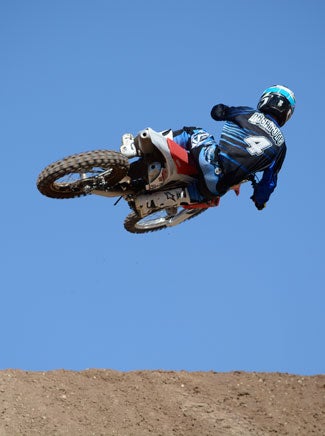
Yet despite that and the one or two other nitpicks we found, we believe that Honda has done an excellent job with the 2015 CRF450R, and we expect it to be a serious contender for best-in-class honors. Its approach is a little less aggressive and a little more polished than some of its competition, and it is clearly a machine capable of keeping pros happy while helping less experienced riders transition to that next skill level. The Engine Mode Select button alone goes a long toward accomplishing that, and the new KYB PSF fork is extremely impressive.
You can expect to be seeing red at your local motocross track this season.
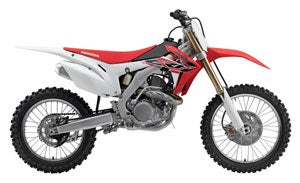 2015 CRF450R Specifications
2015 CRF450R Specifications
MSRP: $8699
Engine Type: 449cc liquid-cooled single-cylinder four-stroke
Bore and Stroke: 96.0mm x 62.1mm
Compression Ratio: 12.5:1
Valve Train: Unicam, four-valve; 36mm intake, titanium; 31mm exhaust, steel
Induction: Dual-Timing PGM-FI, 46mm throttle body
Ignition: Full transistor with electronic advance
Transmission: Close-ratio five-speed
Final Drive: #520 chain; 13T/48T
Suspension
Front: 48mm inverted KYB PSF (Pneumatic Spring Fork) with air-adjustable spring rate, and rebound and compression-damping adjustability; 12.2 inches travel.
Rear: Pro-Link® KYB single shock with adjustable spring preload, rebound damping adjustability, and compression damping adjustment separated into low-speed and high-speed; 12.4 inches travel
Brakes
Front: Single 260mm wave-style disc with twin-piston caliper
Rear: Single 240mm wave-style disc
Tires
Front: Dunlop MX52 80/100-21
Rear: Dunlop MX52 120/80-19
Wheelbase: 58.7 inches
Rake (Caster angle): 27° 04’ (‘= minutes)
Trail: 116mm (4.6 inches)
Seat Height: 37.5 inches
Ground Clearance: 13.0 inches
Fuel Capacity: 1.7 gallons
Claimed Curb Weight*: 243.0 pounds
Color: Red
MSRP: TBA
*Includes all standard equipment, required fluids and full tank of fuel—ready to ride.
 Your Privacy Choices
Your Privacy Choices